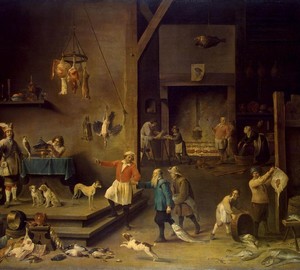
Description of the picture:
Kitchen – David Teniers the Younger. 1640s Canvas, oil. 172.5×237
On a monumental canvas, David Teniers the Younger presented himself in the image of a wealthy nobleman. He is depicted on the left on a stepped platform, in a fancy dress falconry. A falcon sits on his left hand, with his right hand he rests on a cane; at the feet are hunting dogs. A careful, sharply directed gaze indicates that the artist was closely studying his reflection in the mirror. A similar modeling of the painter’s face (with brown eyes, a large nose, the tip of which is slightly upturned, with a small mustache over half-open puffy lips and a chin extended forward) can be seen in the early signature “Self-portrait”. This Self-Portrait, which recently appeared in art history literature, once again confirmed that Teniers himself is undoubtedly depicted in the Hermitage painting.
The action of the picture is most likely not in the real, but in the interior invented by the artist. Although various assumptions have been made in the literature: either it is the interior of Teniers’ kitchen on the estate “Three Towers” (“De Dry Toren”, or Dreytoren Castle), or the image of the kitchen in the palace of Archduke Leopold Wilhelm. But since the Dreytoren castle in the vicinity of the village of Perk Teniers acquired much later, in 1662, most researchers are inclined to favor the archduke’s palace kitchen on the canvas. However, Teniers becomes the court painter of Leopold Wilhelm and moves to Brussels only in 1651, and the work was created in 1646. Therefore, it is a composed composition.
As for the plot, Babin (1989), and after her Cliche (1991) interpret the Hermitage “Kitchen” as an allegory of the four elements. On the canvas of Teniers, as well as on the engraving of his predecessor Jacques de Hein the Younger (1565-1629), the figure of a falconer with a falcon represents Air. In order to reveal the subtext of this very genre-like figure, the artist places it under a window from which water and light flow. Fire is symbolized by a brazier on the table, the hearth of the furnace and the figures of the cook and his assistants depicted next. Water is represented in the picture by the images of fishermen (in the center and on the right) with fish and sea animals. In the Teniers’ interpretation of the four elements, the falcon figure performs a dual role. In addition to Air, it personifies the elements of the Earth – the hunter is surrounded by dogs and wild game, and all kinds of fruits of the earth (cabbage, roots, apples, etc.) are placed at his feet. In a similar interpretation, Teniers used as a source, in addition to the work of Jacques de Hein the Younger (for whom the Earth is marked by the figure of a hunter), the engraving “Earth” by Nicholas de Breip (1571-1656). The latter shows in abundance the attributes of the Earth, similar to the details of a still life on the nerve plane (left) in “Kitchen” Teniers."